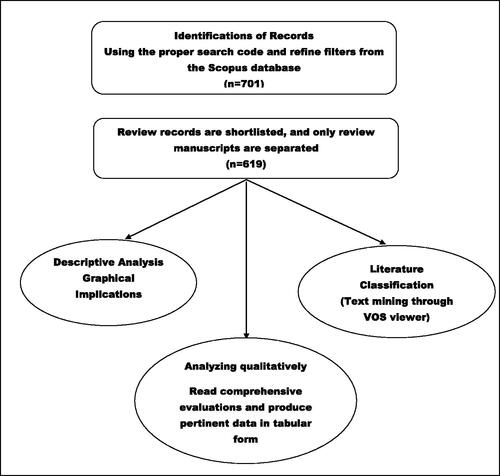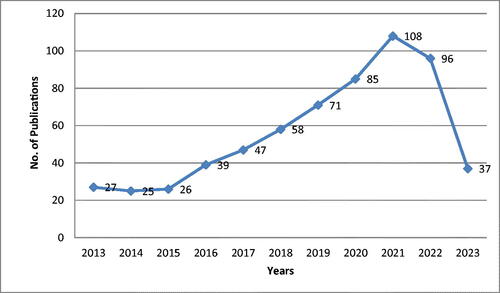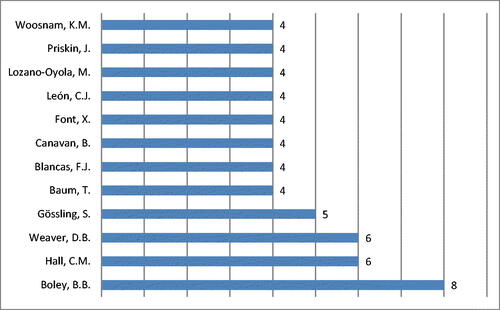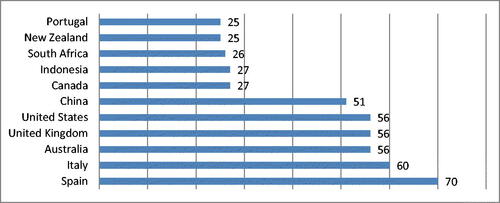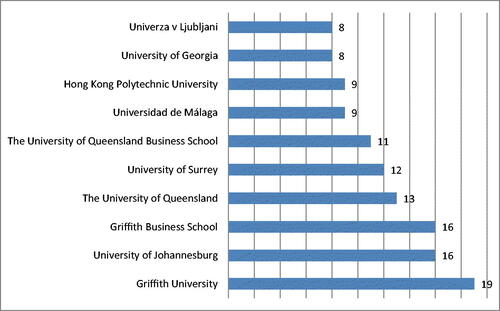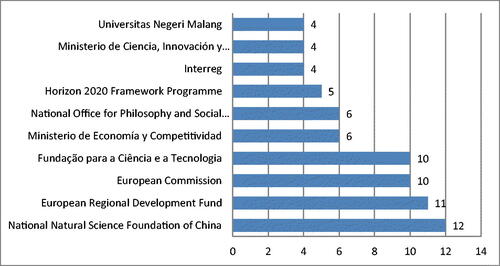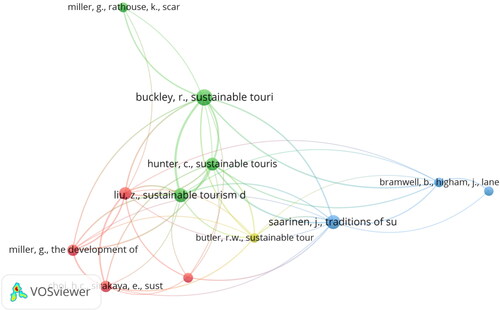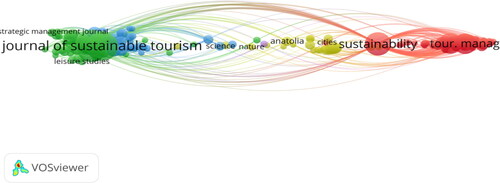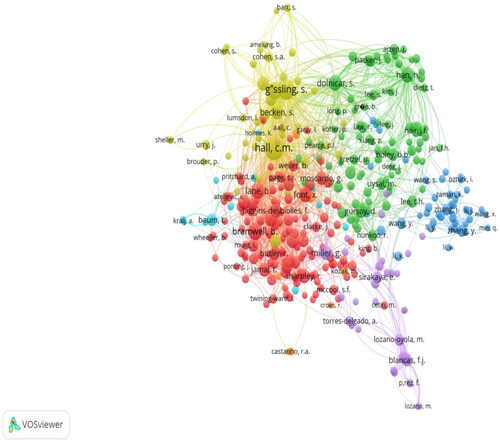Abstract
Sustainability in tourism has become one of the concerns of the travel industry. More research is required to establish a scientific basis for Sustainable Tourism (ST). In order to develop the field structure on sustainable tourism from 2013 to 2023, the study examines the existing situation using bibliometric analysis. The ‘Scopus’ database was explored on the ‘sustainable tourism’ theme in order to achieve the goal. The original search yielded a total of 701 papers, which were subsequently filtered to 619 documents. For the articles relating to ST, the most cited papers, significant authors, co-citation of references, and sources were all looked into. This study found that research into sustainable tourism has grown recently. Three research with 1512 citations were found by the authors, and they also found two publications with over 500 ‘Scopus’ citations. The study highlights the gap and identifies the conceptual sub-domains, such as biodiversity, economic, environmental issues, and local community engagement, which might be crucial in subsequent studies.
REVIEWING EDITOR:
1. Introduction
Economic growth has raised public understanding of sustainability and balanced economic development (Hockerts, Citation2015; Lee, Citation2020). Because of rising consumption, natural resources are under stress and the ecosystem is suffering. Consequently, issues related to water and issues including resource depletion, biodiversity loss, climate change, and air pollution must be addressed (Cavalcante et al., Citation2021; Lopes et al., Citation2021; Martial et al., Citation2023). The importance of sustainability in company development has been stressed in this environment, and interest in theoretical and empirical study has increased (Mathew & Sreejesh, Citation2017). Sustainability has emerged as a key concern for company continuity in the tourism industry. The protection of tourist destinations’ natural resources is essential, coupled with ensuring their continued economic viability (Elmo et al., Citation2020) Thus, environmental protection and sustainability in tourism became important issues, spawning a number of new research areas (Grilli et al., Citation2021; Uddin et al., Citation2023), and assisting in the steady growth of travel destinations. Being seen as sustainable is crucial for tourist organizations’ survival and growth, not merely as a competitive advantage (Iniesta-Bonillo et al., Citation2016; Brieby et al., Citation2020). Being regarded as sustainable can result in favorable perceptions of businesses and significant gains in the bond between customers and brands.
An approach to travel and tourism known as sustainable tourism, often referred to as eco-tourism or responsible tourism, aims to reduce negative effects on the environment, help local people, and promote cultural preservation (Lee & Jan, Citation2019). It entails actions that safeguard biodiversity, preserve natural resources, and improve locals’ quality of life (Buckley, Citation2012). Sustainable tourism puts an emphasis on reducing its negative effects on the environment (Deery et al., Citation2012). It entails actions like lowering energy and trash output, preserving water, safeguarding animals and natural ecosystems, and encouraging environmentally friendly transportation options (Dolnicar & Leisch, Citation2008). By including them in decision-making processes and ensuring that tourism activities generate economic possibilities for locals, sustainable tourism seeks to benefit local communities (Maria, Citation2000). Local businesses are supported, local cultures and traditions are respected, and it promotes locals’ empowerment. The cultural heritage of a destination is respected and valued in sustainable tourism (Buckley, Citation2012). It encourages the preservation of historical sites, conventional crafts, indigenous knowledge, and regional traditions. Travelers are urged to interact with local communities in a respectful manner and learn about their way of life. By ensuring that tourism-related revenue stays in the destination, sustainable tourism aims to maximize the economic benefits for regional communities. Supporting locally run hotels, eateries, and tour companies can help achieve this (Byrd, Citation2007). Additionally, it promotes the development of viable livelihoods for locals. Travelers must be informed about the value of responsible travel habits in order for tourism to be sustainable (Pan et al., Citation2019). Raising awareness about cultural sensitivity, environmental preservation, and the effects of tourism on local populations are all part of this. On their journeys, travelers are urged to adopt sustainable habits and make educated decisions. Planning and managing tourist attractions carefully is necessary for sustainable tourism. This entails striking a balance between tourism growth, environmental preservation, and neighborhood demands. Zoning laws, studies of carrying capacities, and the adoption of sustainable tourist practices at all levels are all included. The main aim of sustainable tourism is to ensure that current and future generations may benefit from a destination’s natural and cultural assets. It encourages a more responsible and well-rounded travel philosophy that considers the long-term viability of the environment as well as the local communities.
The natural resources of travel locations are being stressed by an increase in nature-based tourism. While there has been some research on sustainable tourism, it is not a widely studied topic. Despite the fact that there appears to be increased interest in the subject, some publications, Bibliographic research on sustainability in tourism are relatively rare (Niñerola et al., Citation2019). Even if bibliometric studies are becoming more popular, there are still many prospects for this methodology in the sustainability area (Suban, Citation2022), specifically in terms of predicting future trends and orientations. A thorough approach is needed to properly understand the issue, even if attempts have been made to identify a few key indicators and solutions to sustainable concerns (Rasoolimanesh et al., Citation2020).
Although it is growing in popularity, there hasn’t been much bibliometric research on sustainable tourism (Weaver & Lawton, Citation2007). Furthermore, while being an important part of tourism, sustainable tourism is currently understudied and needs further research to have a solid scientific foundation (Ruhanen et al., Citation2015). As a result, research into the growth of sustainable tourism is required (Vasseur et al., Citation2022). However, there is still a lot of research to be done in order to understand the factors that contribute to and produce successful sustainable tourism (Marinello et al., Citation2023; Sahahiri et al., Citation2023).
This paper aims to provide a bibliometric approach (Suban et al., Citation2021; Suban, Citation2022) to tourism sustainability research, identifying the state of the art in this field and, more specifically, identifying trends and other key indicators. To do this, we surveyed the articles published on Scopus and then processed them with VOSviewer software. We identify the demands and potential areas for tourism sustainability research based on a content analysis of current research studies.
In this investigation, the following research questions are addressed:
From 2013 to 2023, what will the citation structure, impact, and productivity be?
Which sustainable tourism publications received the most citations between 2013 and 2023?
What countries and associations do the leading proponents of sustainable tourism (ST) often belong to?
In ST articles, what social structure may be seen?
It is anticipated that assessing scientific output will assist in organizing forthcoming research. In addition, it is intended that by locating and analyzing papers and trends in this area, the study’s results can advance academic understanding.
2. Review of literature
2.1 Sustainable tourism
Many research projects have been carried out over the years to comprehend and encourage sustainable tourism practices. The important sustainable tourism research topics and results include environmental assessment (Carlisle et al., Citation2022; Seguí & Aldana Citation2023; Wang et al., Citation2023), community engagement (Shrestha & L’Espoir Decosta, Citation2023; Lasso & Dahles, Citation2023), safeguarding culture (Gonia & Jezierska-Thöle, Citation2022; Roberts et al., Citation2022) and biodiversity (Olszewski-Strzyżowski, Citation2022) along with economic benefits for the locals especially women (Voumik et al.,Citation2023), organization, country and world.
Haldane et al. (Citation2023) examined how tourism-related activities affect the environment, including how much energy, water, waste, and greenhouse gases are produced. Vasseur et al. (Citation2022) formulated plans to lessen tourism’s impact on the environment and promote sustainability (Novaczek et al., Citation2011). Numerous studies have looked at the part that local communities play a significant part in the growth of sustainable tourism (Moayerian et al., Citation2022; Mtapuri et al., Citation2022). Wirahayu et al. (Citation2022) suggested that community involvement, capacity building, and empowerment (Sumarmi et al., Citation2022) are crucial for ensuring that locals benefit from tourism, promotes social inclusion, and sustains local livelihoods (Ramaano, Citation2022). Researchers have looked into the connection between tourism and the preservation of biodiversity. In order to preserve natural ecosystems and species, they have looked into the efficacy of protected areas, nature reserves, and sustainable tourist practices (Gültekin, Citation2022; Šergo et al., Citation2022). Sustainable research conducted by Lim et al. (Citation2023). has concentrated on figuring out how tourism affects regional cultures and historic monuments Jeong et al. (Citation2023) examined the results of mass tourism, cultural commodification, and cultural deterioration. Researchers have suggested tactics to encourage community-based tourism, cultural preservation (Halim et al., Citation2022) and tourists who appreciate and participate in local traditions. Effective destination management and planning are essential for sustainable tourism (Conti et al., Citation2023). Multiple researches are conducted on carrying capacity, visitor control strategies, zoning, and the creation of sustainable infrastructure (Nolasco-Cirugeda et al., Citation2022; Stoica et al., Citation2022). In order to promote sustainable practices, researchers have also looked at how legislative frameworks, rules, and certification programmes might help (Zamfir & Corbos, Citation2015; Shrestha & L’Espoir Decosta, Citation2023; Romão et al., Citation2014) have looked into the value of partnerships and stakeholder collaboration in sustainable tourism. In order to achieve sustainable tourism development, it is necessary to bring together a number of stakeholders, such as governments, local communities, tourism enterprises, NGOs, and tourists themselves (Byrd, Citation2007; Hu et al., Citation2019; Manaf et al., Citation2018). Research has concentrated on figuring out how tourists feel about sustainable tourism and what they want to do (Brieu et al., Citation2013; Ryglová et al., Citation2018). Studies have looked into what influences consumer decisions, how well sustainability labels and certifications work, and how well education and awareness campaigns work to promote ethical travel (Eiseman, Citation2018; Luque-Martínez et al., Citation2019; Vinzenz et al., Citation2019; Yang et al., Citation2020). Studies have looked at how sustainable tourism affects local economies in terms of job creation, revenue generation, and economic development (Brandão et al., Citation2014; Dvarskas, Citation2017; Pratt et al., Citation2018; Thompson et al., Citation2018) Studies have compared sustainable tourism practices against traditional tourism models to determine which is more cost-effective (Kim & Kim, Citation2020; Włodarczyk & Cudny, Citation2022; Zagonari, Citation2019). These are only a handful of the study areas for sustainable tourism. As researchers, practitioners, and decision-makers work to create and execute sustainable tourism practices that balance environmental, socio-cultural, and economic factors, the area is always changing.
2.2. Sustainable Tourism bibliometric analysis
Several concepts are included in sustainable tourism. Since the initial publication of the paper, the body of literature has expanded quickly. In the literature on tourism, bibliometric evaluations of journals are most frequently utilized (Niñerola et al., Citation2019). Koseoglu (Citation2016) did study in this area with the goal of offering a substantial inquiry and offering suggestions for the growth of theory. Bibliometric techniques have shed light on prolific and well-known academics and/or institutions, intellectual structure, methodologies, the knowledge domain by year and the geographical areas of various disciplines in multiple studies. In their study, Ruhanen et al. (Citation2015) looked at trends and patterns in the last 25 years of sustainable tourism research. In a bibliometric analysis, Della Corte et al. (Citation2019) identified a substantial correlation between sustainable tourism and its relationships to marketing activities. Niñerola et al. (Citation2019) examined 4647 articles about sustainable tourism issues that were written between 1987 and 2018 and discovered that there is a lot of room for growth in the field of tourism literature. With 492 published publications, various research gaps leading to interesting study themes are found through bibliometric analysis (Celebi et al., Citation2020). Cavalcante et al. (Citation2021) analysed 694 articles and identified gaps and research opportunities in sustainability and tourism marketing.
3. Methodology
3.1. Bibliometric analysis
Bibliometric investigations are distinguished by the statistical analysis of academic literature that they employ. Guilera et al. (Citation2013) stated that the number of papers & authors, productivity of authors, and productivity of nations or journals are important bibliometric indicators. In order to identify important subject areas and patterns, studies have examined the subject indices of the journal using content analysis techniques (Xiao & Smith, Citation2006). Several studies have evaluated titles, abstracts, and keywords to collectively identify subject categories or themes (Weiler et al., Citation2012), and others have sampled entire articles (Ballantyne et al., Citation2009). The overall number of publications, most-cited papers, total citations, productive authors, nations, and universities are all included in our performance analysis. We quantify productivity and impact using the h-index, which compares publications and citations to assess a writer’s contribution to scientific research (Lu and Nepal, Citation2009). We investigated the co-occurrence of source, author, author keywords (Donthu et al., Citation2020), and document co-citations utilizing scientific mapping (network analysis) and VOSviewer. Bibliometric analysis is frequently employed in conjunction with the network visualisation application VOSviewer (Donthu et al., Citation2021; Cavalcante et al., Citation2021; Garrigos-Simon et al., Citation2019; Leong et al., Citation2021; Nusair et al., Citation2019; Suban et al., Citation2021).
The complete process is explained with help of flowchart in .
3.2. Identification of keywords
To find articles with sustainable tourism in their titles or keywords, the original search employed the following Boolean string: TITLE-ABS-KEY (‘Sustainability’ AND ‘Tourism’ AND ‘Sustainable tourism’ AND ‘ecotourism’) AND PUBYEAR > 2012 AND PUBYEAR < 2024 AND (LIMIT-TO (LANGUAGE, ‘English’)) AND (LIMIT-TO (DOCTYPE, ‘ar’))
Search was done by putting the above keywords in the search tab of Scopus.com. The first search yielded 701 results and a filter was put on selecting only the articles and the results for the same were- 619 articles in Scopus. The Year limit applied to search – 2013–2023 (till present), 1/6/2023 at 9:25 A:M. The Language considered was English only.
3.3. Initial search
Researcher used the ‘Scopus’ database for bibliometric information on sustainable tourism and ecotourism on 1 June 2023, at 9:30 AM, focusing primarily on articles released between 2013 and 1 June 2023. Many quantitative studies (Johnson & Samakovlis, Citation2019; Sharma et al., Citation2021) used Scopus as the major and best-organized database. The initial search turned up 701 papers, which were subsequently narrowed down based on the standards mentioned in the sections below.
3.4. Inclusion and Exclusion
There are 623 articles, 18 book chapters, 16 conference papers, 29 reviews and 12 books in all, with 619 final papers and 01 article under production. The initial results do not include editorials, letters, notes, or articles published in German, Polish, Russian, Chinese, Greek, Croatian, Hungarian, Italian, Japanese, Moldavian, Moldovan, Romanian, Slovenian, or Turkish. After deleting duplicates and unnecessary articles, our technique turned up 619 connected documents that were published between 2013 and 2023. In our subsequent discussion, we will refer to these papers as publications, works, documents, or simply article.
4. Findings
The findings of this article were derived from three distinct analyses. The study first looks at the format of document citations. Second, it examined the sustainable tourism related authors and articles with the highest citation counts. The analysis also examined how sustainable tourism authors, references, and journals were cited together.
4.1. Performance analysis
In bibliometric research, performance analysis evaluates the productivity, influence, and impact of academic publications, authors, journals, or organizations. Bibliometric employs quantitative techniques, such as, Citation analysis, Authorship analysis, Citation Networks, Mapping, and Visualization, to examine patterns and trends in scholarly literature.
4.1.1. Citation analysis
It is a research methodology that involves looking at the citations found in academic texts like books, essays, and conference papers in order to analyze patterns of scholarly communication and assess the influence and impact of research. When conducting citation analysis various components such as citation count, citation network, citations by field or discipline, co-citation analysis, bibliographic coupling are examined by researchers. In bibliometric, scientometric, and information science, citation analysis is frequently employed to assess the significance of research, pinpoint significant texts, and chart the evolution of scientific disciplines. Citation analysis is frequently used by academics and organizations to evaluate the caliber of scholarly output, allocate money, and make defensible choices about employment and research collaborations. looks at the citation pattern of the area under investigation. One can look at things like how many citations a paper has received, how many of its authors have little to no academic experience, and other things. We may also compare citations from other literature research. In this case, the majority of citations in the ST literature are accounted for by a small number of works. In the past ten years, 52% of papers have received more than 1000 citations.
Table 1. General citation: structure in sustainable tourism.
The top 10 publications cited most frequently are shown in based on the Scopus database. The Beall et al. (Citation2021) study garnered the most citations (545), followed by Gössling (Citation2018) with 509 citations, and Dolnicar et al. (Citation2019) with 458 citations. Juvan and Dolnicar (Citation2014), Trišić et al. (Citation2023), and Gössling and Peeters (Citation2015) all cited the following three works more than 300 times. More than 200 citations have been made to last four publications (Bausch et al., Citation2021; Lee et al., Citation2021; Mooney et al., Citation2022; Warren et al., Citation2018). Given the field’s explosive expansion, we predict that citations will soon rise.
Table 2. Most-cited papers on sustainable tourism.
Many researchers have made substantial contributions to the subject of sustainable tourism research since its beginning. We discovered 618 authors who published publications about ST between 2013 and 2023 in our database. represented a ranking list of the top fifteen authors with the highest citation numbers across all of their Scopus articles to find the most relevant authors. According to the table, the most influential reference authors in the discipline in terms of citations are Beall (545 citations), Gossling (509 citations), and Dolnicar (458 citations). We added the total publications of each author on the topic in addition to the number of citations to see if sustainable tourism is indeed an appropriate study topic in their profession. As a result, we can distinguish writers like Juvan, who have 373 citations but only one publication on the issue, from those who have a wide range of literature but only 200 citations. The h-index, which compares papers and citations to assess an authors’ scientific research output, is also accessible (Lu & Nepal, Citation2009). A higher h-index suggests that a study’s impact is significant. Lee, has the highest index of any author (81), followed by Gössling, S. (66), and Dolnicar, S. (61).
Table 3. The most influential authors in terms of citations on sustainable tourism.
4.1.2. Publications by year
The publishing status for sustainable tourism between 2013 and 31 May 2023 is shown in . There were few publications between 2013 and 2015. After 2015, academics started to focus on sustainable tourism. There were 39 articles published in 2016 and 47 publications in 2017. We observed a definite upward trend in a number of publications starting in 2018. According to the study’s findings, the number of publications on sustainable tourism increased significantly until 2021, when it reached 108 articles, before starting to decline in 2022. Given that there are now 37 publications as of 31 May 2023, we are optimistic that this number will reach 70 by the end of the year.
4.1.3. Papers by Authors
A list of authors with publications on sustainable tourism is shown in . 619 papers altogether, by 159 authors, were included in the published collection. Boley, B.B., who has contributed the most articles, has eight, followed by Hall, Weaver, who have six, and Gossling, who has written five articles in the past ten years. 20 authors had authored 2 pieces, while 8 authors had written 4, 22 authors had written 3, and 256 authors had written 1 article.
4.1.4. Papers by Country
lists the countries that publish the most publications on sustainable tourism. With 70 appearances, Spain came in first, followed by Italy with 60 publications, Australia, the United Kingdom, and the United States with 56 each, China with 51 articles, Canada with 27 articles, Indonesia with 26 articles, South Africa with 26 documents, and New Zealand, Portugal with 25 documents.
4.1.5. Author affiliation
displays research on sustainable tourism from different universities and institutes throughout the world. Researchers from 169 universities from around the world contributed to our sample of 619 papers, and the contributions of the top 10 universities to sustainable tourism are displayed here.
Maximum 19 publications were published by scholars from Griffith University, followed by sixteen papers apiece from Griffith Business School and the University of Johannesburg, and thirteen papers from The University of Queensland. Twelve documents were published by researchers from the University of Surrey, followed by eleven from the University of Queensland Business School, nine each from the Universidad de Málaga and the Hong Kong Polytechnic University, and eight from the Universities of Georgia and Ljubljana each.
4.1.6. Funding sponsor
shows the number of research projects on sustainable tourism that have been funded by various organizations around the world. The research publications were funded by 159 organizations from throughout the world. The National Natural Science Foundation of China financed a maximum of 12 publications, followed by the European Regional Development Fund with 11 articles. Each of the European Commission and Fundaço para a Ciência e a Tecnologia funded ten documents. Six publications were financed by the National Office for Philosophy and Social Sciences and the Ministerio de Economia y Competitividad, respectively.
4.2. Science mapping sustainable tourism development: a critique
4.2.1. Reference Co-citations
This investigation begins with an examination of the co-citations of references. The nodes of the study indicate the associations between the many publications as well as the different research themes in ST. The findings, as shown in , show that the ranking was dominated by Buckley (Citation2012) and was cited 29 times, Liu, (Citation2003) and Saarinen (2006), were cited 21 times in the reference list of the 619 papers associated to sustainable tourism. These articles also ranked first, second and third in the link strength categories, with scores of 82, 56 and 63, respectively. The paper by Buckley (Citation2012) led the dark green cluster and the red color cluster on the paper by Liu (Citation2003) and blue cluster on the paper by Saarinen (2006). The paper with bottle green color cluster by Hunter (1997) with 18 citations and 81 total link strength, the document with dark green color cluster (Sharpley, 2000) has 17 citations (Daspit, 2017), with 16 citations. The articles with 14 co-citations are Choi, H.C et al., and Miller et al. (Citation2010). Bramwell and Lane (2011) and Miller et al. (Citation2010) have got 11 citations respectively.
4.2.2. Co-citations of source
This study focused on the journal co-citation link on ST after examining the reference’s co-citation (). The nodes in this study are an accurate representation of the activity and volume of published papers. There are four major clusters and one minor cluster, according to the data. The first red cluster has 64 items, the second green cluster 45, the third blue cluster 27 sources, the fourth dark yellow cluster 15 items, and the fourth purple cluster 7 items. The author of this analysis only looked at sources having 200–2000 citations, and the outcomes of the top five journals are as follows: ‘Journal of Sustainable Tourism’ (2432 citations and 71152 link strength), ‘Tourism Management’ (1892 citations and 38373 link strength), ‘Annals Of Tourism Research’ (1551 citations and 48914 link strength), ‘Sustainability’ (967 citations and 26454 links), ‘Tourism Management’ (679 citations and 23676 link strength), ‘Current Issues In Tourism, Tourism Geographies, Journal Of Cleaner Production, International Journal Of Hospitality Management, International Journal Of Tourism Research, Journal of Ecotourism, Tourism Recreation Research, Ecological Economics’ are some of the most popular sources for our research area.
4.2.3. Co-citations of authors
The analysis of the key contributors was carried out in this co-citation study. confirms the existence of seven clusters with a total of 355 authors. The top ten co-cited authors are Hall (515 citations, 20070 link strength), Gössling (377 citations and 15953 links), Scott (228 citations and 9826 strength links), Bramwell (210 citations and 8335 links), Lane (184 citations and 7209 links), Dolnicar (169 citations and 7678 links), Han (168 citations and 8773 links), Buckley (151 citations and 5176 links), Font,(151 citations and 4617 links) and Butler (147 citations and 4710 links).
5. Discussion
The Scopus database for papers from 2013 to the present was scanned to identify a recent era of significant scholarly publications on this topic. Uzzo, published the first article with this title in 2013. There has been a significant improvement in the release of academic publications related to this topic since 2016, when the subject started attracting academics’ attention. By 2017, there were 47 publications as a result of the academics’ increased focus on sustainable tourism, which started in 2016. There were 58 articles published in 2018 and 71 publications in 2019. We observed a definite upward trend in a number of publications beginning in 2021. Even though various nations have published articles on the topic, wellness tourism research has not gotten comparable attention worldwide. With 70 papers produced annually, Spain leads the pack, followed by Italy, the United States, the United Kingdom, and Australia. We discovered two papers with over 500 ‘Scopus’ citations, with a total of 1512 citations from just 3 publications.
There were total of 619 authors who published publications about ST between 2013 and 2023, with Beall, Boley, Landon, & Woosnam being the most-cited reference authors in the subject. Lee T, Jan F.-H., Liu J.-T. is the author with the highest index of 81. Researchers from the Griffith University published nineteen papers, followed by Griffith Business School and University of Johannesburg with sixteen documents, The university of Queenland with 13 articles, Hong kong Polytechnic University and Universidad Malaga each with nine documents respectively.
As per the co-citation of reference (Buckley, 2012) were cited 29 times and liu (2003) and saarinen (2006) were cited 21 times in the reference list of the 619 papers. ‘Journal of Sustainable Tourism’ (2432 citations and 71152 link strength), ‘Tourism Management’ (1892 citations and 38373 link strength), ‘Annals Of Tourism Research’ (1551 citations and 48914 link strength), ‘Sustainability’ (967 citations and 26454 links), ‘Tourism Management’ (679 citations and 23676 link strength) are the top five journals with over 7500 citations. According to the Scopus co citation count, Hall, Gossling, and Bramwell, are the most often co-cited authors.
5.1. Theoretical implications
From a scholarly perspective, the bibliometric study completed contributes to the provision of some responses to important questions that academics should take into account while investigating sustainability and tourism. Researchers can gain knowledge from this study about new developments in this field as well as the terminology used in publications that deal largely with these investigations and field reference studies. It gives insight into the subject’s importance and can be applied to the creation of future sustainable tourism services and products. This study employed a bibliometric approach to close this knowledge gap by identifying the journals and, more importantly, the conceptual sub-domains that will be crucial for future research on sustainable tourism, such as environmental assessment, ecological balance, community involvement, biodiversity, cultural preservation, and localization. Therefore, for the next study on sustainable tourism, scholars and industry experts in the field should use the existing findings as a springboard.
5.2. Managerial implications
Sustainable tourism, which emphasizes visiting places while protecting the environment and assisting local populations, is becoming more and more well-liked. Travelers are looking for genuine, outdoorsy experiences, which has sparked the growth of eco-friendly lodging, narrated tours, and outdoor pursuits that place a strong emphasis on environmental education and preservation. Every year, this sector brings in billions of dollars. As embracing practices and tactics that balance economic, environmental, and socio-cultural components of tourism, sustainable tourism has substantial managerial consequences. This knowledge is crucial for managers, policymakers, and industry stakeholders to make informed decisions and implement effective sustainable tourism initiatives. The tourism industry must educate tourists about the advantages of ecotourism. Managers should carefully plan their marketing campaigns to draw tourists by providing them with chances to explore new things, unwind emotionally and physically, and promote social development. Through the identification of new trends, cutting-edge techniques, and market prospects in sustainable tourism, this research study can stimulate industry innovation. The findings may encourage the creation of fresh goods, services, and commercial strategies that adhere to sustainability ideals. The implications of these business methods can help companies stand out from the competition, draw in tourists who care about the environment and the community, and acquire a competitive advantage. Tourism enterprises may support the long-term viability of destinations, cultivate gratifying connections with stakeholders, and guarantee the preservation of natural and cultural resources for future generations by taking these managerial consequences into account. It’s crucial to remember that the tourist sector is constantly changing, and as consumer preferences and sustainable practices change, new trends may appear.
6. Conclusion
A clearer understanding of the Sustainable tourism research is made possible by the current research. This study was carried out over a ten-year period (from 2013 to 6 June 2023) covering the entire period of publishing in this sector and enabling the creation of an exhaustive overview. Since there are very few bibliometric studies on research on sustainable tourism, this is a crucial contribution made by the work.
In conclusion, sustainable tourism is an essential approach that balances the needs of the environment, society, and economy within the context of travel and tourism. By adopting sustainable practices, destinations can minimize their negative impacts, protect natural and cultural heritage, and create a more equitable and resilient tourism industry. As travelers, we can contribute to sustainable tourism by making responsible choices, respecting local cultures and ecosystems, and supporting businesses that prioritize sustainability. Through collective efforts, sustainable tourism has the potential to create a positive and lasting impact on our planet and the well-being of communities worldwide. This conclusion suggests several exciting new research directions. We think that when more recognized international academics from premier universities throughout the world demonstrate a track record of publishing ST studies in top-tier publications, the field of sustainable tourism research will mature.
7. Limitations & future research
Despite the paper’s merits, there are certain issues that need to be resolved, such as the use of a single database rather than several sources for data retrieval. Although we believe Scopus has a sizable number of papers that are representative of the entire, we think using several databases will give the topic more coverage. On the other hand, using the search algorithm in the title alone restricts the search. We excluded unpublished working papers, doctoral theses, textbooks, and conference proceedings from the ST literature. Additionally, because we only looked at publications in English, the value of research done in other languages was diminished. In this study, only the VOSviewer was employed for analysis. Future study can also make use of Tableau, CiteSpace and Gephi in addition to VOSviewer. Future analyses may also include terms linked to sustainable tourism. The researchers can make use of sophisticated bibliometric analysis techniques such as co-word analysis, co-authorship, bibliographic coupling, and clustering.
Future research on sustainable tourism is crucial for addressing emerging challenges, exploring new opportunities, and advancing knowledge in this field. Future studies should examine how well sustainable practices work to cut carbon emissions, how vulnerable coastal areas are to sea level rise, and how to develop creative approaches to tourism that is climate resilient. It would be beneficial to investigate the potential for upcycling, recycling, and lowering single-use plastics in tourism operations. Future studies can examine how cutting-edge technology like virtual reality, block chain, and artificial intelligence can improve sustainable practices. Future studies can concentrate on environmentally friendly transportation options, such as promoting low-carbon modes of transportation, enhancing public transit infrastructure, and analyzing how transportation policies affect travel behavior. Future studies could examine the efficacy of sustainability certifications and standards, analyze how government rules influence the adoption of sustainable practices, and investigate cutting-edge governance models for destination management. Future study should focus on themes such as policy coherence, stakeholder collaboration, and the incorporation of sustainable concepts into tourism policies.
Disclosure statement
There is no conflict of interest involved with this paper. All the authors have legitimate contributions to this paper.
Correction Statement
This article has been corrected with minor changes. These changes do not impact the academic content of the article.
Additional information
Notes on contributors
Pawan Kumar
Pawan Kumar is an associate professor at the Mittal School of Business, Lovely Professional University, Phagwara, Punjab, India. He has 15 years of professional experience in teaching and research. He has conducted various qualitative and quantitative research. His research interests include neuromarketing, social media marketing, sustainable tourism and consumer behaviour. He is a certified and experienced trainer of SAP-SD.
Bindu Aggarwal
Dr. Bindu Aggarwal is currently an Associate Professor of Marketing in the University School of Business at Chandigarh University, Gharaun, Mohali, Punjab, India. She has teaching experience of 18 years. She completed her Ph.D in marketing from the Lovely Professional University, Punjab, India in the year 2021. Her areas of interest include marketing, human resource management, current issues in management and psychology. She has presented more than 35 research papers related to marketing, human resource management and psychology at the conferences/seminars held at national and international levels. She has also published papers in various reputed national and international journals.
Vinod Kumar
Dr. Vinod Kumar is an Associate Professor in Maharishi Markandeshwar (Deemed to be University), Mullana, Ambala. His research interest areas are branding and service marketing. He has 14 years of experience in management teaching. He has published more than 30 publications in reputed journals along with various patents and copyrights.
Harish Saini
Harish Saini is a Doctoral Candidate of Management at Mittal School of Business, Lovely Professional University, Phagwara, Punjab, India. His research areas include influencers marketing, destination marketing, travel decision-making, responsible travel, and sustainable tourism development. He has a master’s degree in business administration and qualified for UGC-NET. He has attended various national and international conferences and workshops
References
- Ballantyne, R., Packer, J., & Axelsen, M. (2009). Trends in tourism research. Annals of Tourism Research, 36(1), 1–18. https://doi.org/10.1016/j.annals.2008.07.001
- Bausch, T., Schröder, T., Tauber, V., & Lane, B. (2021). Sustainable tourism: The elephant in the room. Sustainability, 13(15), 8376. https://doi.org/10.3390/su13158376
- Beall, J. M., Boley, B. B., Landon, A. C., & Woosnam, K. M. (2021). What drives ecotourism: environmental values or symbolic conspicuous consumption? Journal of Sustainable Tourism, 29(8), 1215–1234. https://doi.org/10.1080/09669582.2020.1825458
- Brandão, C. D. N., Barbieri, J. C., & Junior, E. R. (2014 Analysis of the social, cultural, economic and environmental impacts of indigenous tourism: a multi-case study of indigenous communities in the Brazilian Amazon. Sustainable Tourism, 187, 175–185. https://doi.org/10.2495/ST140141
- Breiby, M. A., Duedahl, E., Øian, H., & Ericsson, B. (2020). Exploring sustainable experiences in tourism. Scandinavian Journal of Hospitality and Tourism, 20(4), 335–351. https://doi.org/10.1080/15022250.2020.1748706
- Brieu, M., Durif, F., Roy, J., & Boivin, C. (2013). What triggers consumers’ interest toward sustainable tourism? International Journal of Sustainable Development, 16(3/4), 322–334. https://doi.org/10.1504/IJSD.2013.056558
- Buckley, R. (2012). Sustainable tourism: Research and reality. Annals of Tourism Research, 39(2), 528–546. https://doi.org/10.1016/j.annals.2012.02.003
- Byrd, E. T. (2007). Stakeholders in sustainable tourism development and their roles: applying stakeholder theory to sustainable tourism development. Tourism Review, 62(2), 6–13. https://doi.org/10.1108/16605370780000309
- Carlisle, S., Ivanov, S., Dijkmans, C., & Marco-Lajara, B. M. L. (2022). Environmental skills gaps in tourism and hospitality organisations: Evidence from Europe. Tourism, 70(3), 411–431. https://doi.org/10.37741/t.70.3.6
- Cavalcante, W. Q. D. F., Coelho, A., & Bairrada, C. M. (2021). Sustainability and tourism marketing: A bibliometric analysis of publications between 1997 and 2020 using vosviewer software. Sustainability, 13(9), 4987. https://doi.org/10.3390/su13094987
- Celebi, D., Pirnar, I., & Eris, E. D. (2020). Bibliometric analysis of social entrepreneurship in gastronomy tourism. Tourism, 68(1), 58–67. https://doi.org/10.37741/t.68.1.5
- Conti, S., Dias, Á., & Pereira, L. (2023). Perceived city sustainability and tourist behavioural intentions. Smart Cities, 6(2), 692–708. https://doi.org/10.3390/smartcities6020033
- Deery, M., Jago, L., &Fredline, L. (2012). Rethinking social impacts of tourism research: A new research agenda. Tourism Management, 33(1), 64–73. https://doi.org/10.1016/j.tourman.2011.01.026
- Della Corte, V., Del Gaudio, G., Sepe, F., & Sciarelli, F. (2019). Sustainable tourism in the open innovation realm: a bibliometric analysis. Sustainability, 11(21), 6114. https://doi.org/10.3390/su11216114
- Dolnicar, S., & Leisch, F. (2008). Selective marketing for environmentally sustainable tourism. Tourism Management, 29(4), 672–680. https://doi.org/10.1016/j.tourman.2007.07.010
- Dolnicar, S., Knezevic Cvelbar, L., & Grün, B. (2019). A sharing-based approach to enticing tourists to behave more environmentally friendly. Journal of Travel Research, 58(2), 241–252. https://doi.org/10.1177/0047287517746013
- Donthu, N.,Kumar, S.,Mukherjee, D.,Pandey, N., &Lim, W. M. (2021). How to conduct a bibliometric analysis: An overview and guidelines. Journal of Business Research, 133, 285–296. https://doi.org/10.1016/j.jbusres.2021.04.070
- Donthu, N.,Kumar, S., &Pattnaik, D. (2020). Forty-five years of journal of business research: A bibliometric analysis. Journal of Business Research, 109, 1–14. https://doi.org/10.1016/j.jbusres.2019.10.039
- Dvarskas, A. (2017). Dynamically linking economic models to ecological condition for coastal zone management: Application to sustainable tourism planning. Journal of Environmental Management, 188, 163–172. https://doi.org/10.1016/j.jenvman.2016.12.014
- Eiseman, D. (2018). Marketing sustainable tourism: Principles and practice. In Tourism planning and destination marketing (pp. 121–140). Emerald Publishing Limited.
- Elmo, G. C., Arcese, G., Valeri, M., Poponi, S., & Pacchera, F. (2020). Sustainability in tourism as an innovation driver: An analysis of family business reality. Sustainability, 12(15), 6149. https://doi.org/10.3390/su12156149
- Garrigos-Simon, F. J.,Narangajavana-Kaosiri, Y., &Narangajavana, Y. (2019). Quality in tourism literature: A bibliometric review. Sustainability, 11(14), 3859. https://doi.org/10.3390/su11143859
- Gonia, A., & Jezierska-Thöle, A. (2022). Sustainable tourism in cities – Nature reserves as a ‘New’City space for nature-based tourism. Sustainability, 14(3), 1581. https://doi.org/10.3390/su14031581
- Gössling, S. (2018). Tourism, tourist learning and sustainability: An exploratory discussion of complexities, problems and opportunities. Journal of Sustainable Tourism, 26(2), 292–306. https://doi.org/10.1080/09669582.2017.1349772
- Gössling, S., & Peeters, P. (2015). Assessing tourism’s global environmental impact 1900–2050. Journal of Sustainable Tourism, 23(5), 639–659. https://doi.org/10.1080/09669582.2015.1008500
- Grilli, G., Tyllianakis, E., Luisetti, T., Ferrini, S., & Turner, R. K. (2021). Prospective tourist preferences for sustainable tourism development in Small Island Developing States. Tourism Management, 82, 104178. https://doi.org/10.1016/j.tourman.2020.104178
- Guilera, G., Barrios, M., & Gómez-Benito, J. (2013). Meta-analysis in psychology: A bibliometric study. Scientometrics, 94(3), 943–954. https://doi.org/10.1007/s11192-012-0761-2
- Gültekin, Y. S. (2022). Ecotourism through the perception of forest villagers: understanding via mediator effects using structural equation modeling. Environmental Science and Pollution Research International, 29(47), 70899–70908. https://doi.org/10.1007/s11356-022-20882-y
- Haldane, E., MacDonald, L., Kressin, N., Furlotte, Z., Kınay, P., Guild, R., & Wang, X. (2023). Sustainable tourism in the face of climate change: An overview of prince Edward Island. Sustainability, 15(5), 4463. https://doi.org/10.3390/su15054463
- Halim, S. A., Unjah, T., Ahmad, N., & Komoo, I. (2022). Understanding micro-experiences of heritage conservation in an island-based tourism development: A case of Kubang Badak BioGeoTrail, Langkawi UNESCO Global Geopark, Kedah, Malaysia. In Conserving biocultural landscapes in Malaysia and Indonesia for sustainable development (pp. 111–126). Springer Singapore.
- Hockerts, K. (2015). A cognitive perspective on the business case for corporate sustainability. Business Strategy and the Environment, 24(2), 102–122. https://doi.org/10.1002/bse.1813
- Hu, X., Lovelock, B., Ying, T., & Mager, S. (2019). Stakeholder collaboration on policymaking for sustainable water management in Singapore’s hotel sector: A network analysis. Sustainability, 11(8), 2360. https://doi.org/10.3390/su11082360
- Iniesta-Bonillo, M. A., Sánchez-Fernández, R., & Jiménez-Castillo, D. (2016). Sustainability, value, and satisfaction: Model testing and cross-validation in tourist destinations. Journal of Business Research, 69(11), 5002–5007. https://doi.org/10.1016/j.jbusres.2016.04.071
- Jeong, J. Y., Karimov, M., Sobirov, Y., Saidmamatov, O., & Marty, P. (2023). Evaluating culturalization strategies for sustainable tourism development in Uzbekistan. Sustainability, 15(9), 7727. https://doi.org/10.3390/su15097727
- Johnson, A.-G., &Samakovlis, I. (2019). A bibliometric analysis of knowledge development in smart tourism research. Journal of Hospitality and Tourism Technology, 10(4), 600–623. https://doi.org/10.1108/JHTT-07-2018-0065
- Juvan, E., & Dolnicar, S. (2014). The attitude–behaviour gap in sustainable tourism. Annals of Tourism Research, 48, 76–95. https://doi.org/10.1016/j.annals.2014.05.012
- Kim, S., & Kim, N. (2020). A social cost-benefit analysis of the vehicle restriction policy for reducing overtourism in Udo, Korea. Sustainability, 12(2), 612. https://doi.org/10.3390/su12020612
- Koseoglu, M. A. (2016). Mapping the institutional collaboration network of strategic management research: 1980–2014. Scientometrics, 109(1), 203–226. https://doi.org/10.1007/s11192-016-1894-5
- Lasso, A. H., & Dahles, H. (2023). A community perspective on local ecotourism development: Lessons from Komodo National Park. Tourism Geographies, 25(2–3), 634–654. https://doi.org/10.1080/14616688.2021.1953123
- Lee, T. H., &Jan. F. H. (2019). Can community-based tourism contribute to sustainable development? Evidence from residents’ perceptions of the sustainability. Tourism Management, 70, 368–380. https://doi.org/10.1016/j.tourman.2018.09.003
- Lee, T. H., Jan, F. H., & Liu, J. T. (2021). Developing an indicator framework for assessing sustainable tourism: Evidence from a Taiwan ecological resort. Ecological Indicators, 125, 107596. https://doi.org/10.1016/j.ecolind.2021.107596
- Lee, Y. C. (2020). Communicating sustainable development: Effects of stakeholder-centric perceived sustainability. Corporate Social Responsibility and Environmental Management, 27(4), 1540–1551. https://doi.org/10.1002/csr.1900
- Leong, L.Y ., Hew, T. S., Tan, G. W. H., Ooi, K. B., & Lee, V. H. (2021). Tourism research progress–A bibliometric analysis of tourism review publications. Tourism Review, 76(1), 1–26. https://doi.org/10.1108/TR-11-2019-0449
- Lim, C. K., Tan, K. L., & Farid Ahmed, M. (2023). Conservation of culture heritage tourism: A case study in Langkawi Kubang Badak Remnant Charcoal Kilns. Sustainability, 15(8), 6554. https://doi.org/10.3390/su15086554
- Liu, Z. (2003). Sustainable tourism development: A critique. Journal of Sustainable Tourism, 11(6), 459–475. https://doi.org/10.1080/09669580308667216
- Lopes, H., Remoaldo, P. C. A., Silva, M., Ribeiro, V., & Vide, J. M. (2021). Climate in tourism’s research agenda: Future directions based on literature review. Boletín de la Asociación de Geógrafos Españoles, 2021(90), 8. https://doi.org/10.21138/bage.3116
- Lu, J., &Nepal, S. K. (2009). Sustainable tourism research: An analysis of papers published in the Journal of Sustainable Tourism. Journal of Sustainable Tourism, 17(1), 5–16. https://doi.org/10.1080/09669580802582480
- Luque-Martínez, T., Faraoni, N., & Doña-Toledo, L. (2019). Auditing the marketing and social media communication of natural protected areas. How marketing can contribute to the sustainability of tourism. Sustainability, Sustainability, 11(15), 4014. https://doi.org/10.3390/su11154014
- Manaf, A., Purbasari, N., Damayanti, M., Aprilia, N., & Astuti, W. (2018). Community-based rural tourism in inter-organizational collaboration: How does it work sustainably? Lessons learned from Nglanggeran Tourism Village, Gunungkidul Regency, Yogyakarta, Indonesia. Sustainability, 10(7), 2142. https://doi.org/10.3390/su10072142
- Maria, K. (2000). Tourism and the environment: A social movements perspective. Annals of Tourism Research, 27(2), 468–489.
- Marinello, S., Butturi, M. A., Gamberini, R., & Martini, U. (2023). Indicators for sustainable touristic destinations: A critical review. Journal of Environmental Planning and Management, 66(1), 1–30. https://doi.org/10.1080/09640568.2021.1978407
- Martial, A. A. A., Dechun, H., Voumik, L. C., Islam, M. J., & Majumder, S. C. (2023). Investigating the influence of tourism, GDP, Renewable energy, and electricity consumption on carbon emissions in low-income Countries. Energies, 16(12), 4608. https://doi.org/10.3390/en16124608
- Mathew, P. V., & Sreejesh, S. (2017). Impact of responsible tourism on destination sustainability and quality of life of community in tourism destinations. Journal of Hospitality and Tourism Management, 31, 83–89. https://doi.org/10.1016/j.jhtm.2016.10.001
- Miller, G.,Rathouse, K.,Scarles, C.,Holmes, K., &Tribe, J. (2010). Public understanding of sustainable tourism. Annals of Tourism Research, 37(3), 627–645. https://doi.org/10.1016/j.annals.2009.12.002
- Moayerian, N., McGehee, N. G., & Stephenson, M. O.Jr. (2022). Community cultural development: Exploring the connections between collective art making, capacity building and sustainable community-based tourism. Annals of Tourism Research, 93, 103355. https://doi.org/10.1016/j.annals.2022.103355
- Mooney, S., Robinson, R., Solnet, D., & Baum, T. (2022). Rethinking tourism’s definition, scope and future of sustainable work and employment: Editorial for the Journal of Sustainable Tourism special issue on “locating workforce at the heart of sustainable tourism discourse”. Journal of Sustainable Tourism, 30(12), 2707–2725. https://doi.org/10.1080/09669582.2022.2078338
- Mtapuri, O., Camilleri, M. A., & Dłużewska, A. (2022). Advancing community-based tourism approaches for the sustainable development of destinations. Sustainable Development, 30(3), 423–432. https://doi.org/10.1002/sd.2257
- Niñerola, A., Sánchez-Rebull, M. V., & Hernández-Lara, A. B. (2019). Tourism research on sustainability: A bibliometric analysis. Sustainability, 11(5), 1377. https://doi.org/10.3390/su11051377
- Nolasco-Cirugeda, A., García-Mayor, C., Lupu, C., & Bernabeu-Bautista, A. (2022). Scoping out urban areas of tourist interest though geolocated social media data: Bucharest as a case study. Information Technology & Tourism, 24(3), 361–387. https://doi.org/10.1007/s40558-022-00235-8
- Novaczek, I., MacFadyen, J., Bardati, D., & MacEachern, K. (2011). Social and cultural values mapping as a decision-support tool for climate change adaptation. The Institute of Island Studies, University of Prince Edward Island.
- Nusair, K.,Butt, I., &Nikhashemi, S. R. (2019). A bibliometric analysis of social media in hospitality and tourism research. International Journal of Contemporary Hospitality Management, 31(7), 2691–2719. https://doi.org/10.1108/IJCHM-06-2018-0489
- Olszewski-Strzyżowski, D. J. (2022). Promotional activities of selected National Tourism Organizations (NTOs) in the Light of Sustainable Tourism (Including Sustainable Transport). Sustainability, 14(5), 2561. https://doi.org/10.3390/su14052561
- Pan, X., Yang, Z., Han, F., Lu, Y., & Liu, Q. (2019). Evaluating potential areas for mountain wellness tourism: A case study of Ili, Xinjiang Province. Sustainability, 11(20), 5668. https://doi.org/10.3390/su11205668
- Pérez González, A. R., Andrade Palacios, J. C., & Castro Quelal, L. R. (2022). Marketing management and sustainable tourism in the Imbabura geopark, Ecuador. Smart Tourism, 3(2), 10.
- Pratt, S., Suntikul, W., & Dorji, U. (2018). Economic sustainability? Examining the linkages and leakages between agriculture and hotels in B hutan. International Journal of Tourism Research, 20(5), 626–636. https://doi.org/10.1002/jtr.2211
- Ramaano, A. I. (2022). The economic-administrative role of geographic information systems in rural tourism and exhaustive local community development in African marginalized communities. Arab Gulf Journal of Scientific Research, 40(2), 180–195. https://doi.org/10.1108/AGJSR-04-2022-0020
- Rasoolimanesh, S. M., Ramakrishna, S., Hall, C. M., Esfandiar, K., & Seyfi, S. (2020). A systematic scoping review of sustainable tourism indicators in relation to the sustainable development goals. Journal of Sustainable Tourism, 31(7), 1497–1517. https://doi.org/10.1080/09669582.2020.1775621
- Roberts, C., Reynolds, J., & Dolasinski, M. J. (2022). Meta-analysis of tourism sustainability research: 2019–2021. Sustainability, 14(6), 3303. https://doi.org/10.3390/su14063303
- Romão, J., Neuts, B., Nijkamp, P., & Shikida, A. (2014). Determinants of trip choice, satisfaction and loyalty in an eco-tourism destination: A modelling study on the Shiretoko Peninsula, Japan. Ecological Economics, 107, 195–205. https://doi.org/10.1016/j.ecolecon.2014.07.019
- Ruhanen, L., Weiler, B., Moyle, B. D., & McLennan, C. L. J. (2015). Trends and patterns in sustainable tourism research: A 25-year bibliometric analysis. Journal of Sustainable Tourism, 23(4), 517–535. https://doi.org/10.1080/09669582.2014.978790
- Ryglová, K., Rašovská, I., Šácha, J., & Maráková, V. (2018). Building customer loyalty in rural destinations as a pre-condition of sustainable competitiveness. Sustainability, 10(4), 957. https://doi.org/10.3390/su10040957
- Sahahiri, R. M., Griffin, A. L., & Sun, Q. (. (2023). Investigating ecotourism opportunities measurements in a complex adaptive system: A systematic literature review. Sustainability, 15(3), 2678. https://doi.org/10.3390/su15032678
- Seguí, A. E., & Aldana, M. C. (2023). Environmental responsibility of tourist agents. Ecoagrotourism proposals in Spain. Investigaciones Turísticas, 2023(25), 1–27.
- Šergo, Z., Gržinić, J., & Zanini Gavranić, T. (2022). A cross-countries analysis of biodiversity loss and tourism demand: Evidence from count models. Tourism, 70(4), 642–655. https://doi.org/10.37741/t.70.4.7
- Sharma, P.,Singh, R.,Tamang, M., Singh, A., &Singh, A. K. (2021). Journal of teaching in travel & tourism: A bibliometric analysis. Journal of Teaching in Travel & Tourism, 21(2), 155–176. https://doi.org/10.1080/15313220.2020.1845283
- Shrestha, R. K., & L’Espoir Decosta, P. (2023). Developing dynamic capabilities for community collaboration and tourism product innovation in response to crisis: Nepal and COVID-19. Journal of Sustainable Tourism, 31(1), 168–186. https://doi.org/10.1080/09669582.2021.2023164
- Stoica, G. D., Andreiana, V. A., Duica, M. C., Stefan, M. C., Susanu, I. O., Coman, M. D., & Iancu, D. (2022). Perspectives for the development of sustainable cultural. Tourism Sustainability, 14(9), 5678. https://doi.org/10.3390/su14095678
- Suban, S. A. (2022). Bibliometric analysis on wellness tourism – Citation and co-citation analysis. International Hospitality Review, 37(2), 359–383. https://doi.org/10.1108/IHR-11-2021-0072
- Suban, S. A., Madhan, K., & Shagirbasha, S. (2021). A bibliometric analysis of Halal and Islamic tourism. International Hospitality Review, 37(2), 219–242. https://doi.org/10.1108/IHR-05-2021-0038
- Sumarmi, S., Bachri, S., Purwanto, P., Zubaidah, S., Shrestha, R. P., & Sholiha, A. W. (2022). Assessing Bedul mangrove ecotourism using green and fair strategy empowerment to fulfill SDGs 2030 Agenda for Tourism. Environmental Research, Engineering and Management, 78(2), 73–87. https://doi.org/10.5755/j01.erem.78.2.31006
- Thompson, B. S., Gillen, J., & Friess, D. A. (2018). Challenging the principles of ecotourism: insights from entrepreneurs on environmental and economic sustainability in Langkawi, Malaysia. Journal of Sustainable Tourism, 26(2), 257–276. https://doi.org/10.1080/09669582.2017.1343338
- Trišić, I., Privitera, D., Ristić, V., Štetić, S., Milojković, D., & Maksin, M. (2023). Protected areas in the function of sustainable tourism development—A case of Deliblato sands special nature reserve, Vojvodina Province. Land, 12(2), 487. https://doi.org/10.3390/land12020487
- Trišić, I., Privitera, D., Ristić, V., Štetić, S., Milojković, D., & Maksin, M. (2023). Protected areas in the function of sustainable tourism development – A case of Deliblato sands special nature reserve, Vojvodina Province. Land, 12(2), 487. https://doi.org/10.3390/land12020487
- Uddin, H., Ahammed, S., Rana, M. M., & Majumder, S. C. (2023). Investigating the relationship between environmental quality and tourism industry in Thailand. Environment, Development and Sustainability, 2023, 1–27. https://doi.org/10.1007/s10668-023-03801-0
- Vasseur, L., Thornbush, M. J., & Plante, S. (2022). Engaging communities in adaptation to climate change by understanding the dimensions of social capital in Atlantic Canada. Sustainability, 14(9), 5250. https://doi.org/10.3390/su14095250
- Vinzenz, F., Priskin, J., Wirth, W., Ponnapureddy, S., & Ohnmacht, T. (2019). Marketing sustainable tourism: The role of value orientation, well-being and credibility. Journal of Sustainable Tourism, 27(11), 1663–1685. https://doi.org/10.1080/09669582.2019.1650750
- Voumik, L. C., Nafi, S. M., Majumder, S. C., & Islam, M. A. (2023). The impact of tourism on the women employment in South American and Caribbean countries. International Journal of Contemporary Hospitality Management, 35(9), 3095–3112. https://doi.org/10.1108/IJCHM-04-2022-0449
- Wang, Z., Nie, L., Jeronen, E., Xu, L., & Chen, M. (2023). Understanding the environmentally sustainable behavior of chinese university students as tourists: an integrative framework. International Journal of Environmental Research and Public Health, 20(4), 3317. https://doi.org/10.3390/ijerph20043317
- Warren, C., Becken, S., & Coghlan, A. (2018). Sustainability-oriented service innovation: Fourteen-year longitudinal case study of a tourist accommodation provider. Journal of Sustainable Tourism, 26(10), 1784–1803. https://doi.org/10.1080/09669582.2018.1511721
- Weaver, D. B., & Lawton, L. J. (2007). Twenty years on: The state of contemporary ecotourism research. Tourism Management, 28(5), 1168–1179. https://doi.org/10.1016/j.tourman.2007.03.004
- Weiler, B., Moyle, B., & McLennan, C-l (2012). Disciplines that influence tourism doctoral research: the United States, Canada, Australia and New Zealand. Annals of Tourism Research, 39(3), 1425–1445. https://doi.org/10.1016/j.annals.2012.02.009
- Wirahayu, Y. A., Sumarmi, S., Arinta, D., Islam, M. N., & Kurniawati, E. (2022). Developing a sustainable community forest-based village ecotourism in Oro-Oro Ombo, Malang: What is the effect of Batu’s West Ring Road? Revista Turismo & Desenvolvimento, 39, 425–437.
- Włodarczyk, B., & Cudny, W. (2022). Individual low-cost travel as a route to tourism sustainability. Sustainability, 14(17), 10514. https://doi.org/10.3390/su141710514
- Xiao, H., & Smith, S. L. (2006). The maturation of tourism research: Evidence from a content analysis. Tourism Analysis, 10(4), 335–348. https://doi.org/10.3727/108354206776162796
- Yang, J. J., Lo, H. W., Chao, C. S., Shen, C. C., & Yang, C. C. (2020). Establishing a sustainable sports tourism evaluation framework with a hybrid multi-criteria decision-making model to explore potential sports tourism attractions in Taiwan. Sustainability, 12(4), 1673. https://doi.org/10.3390/su12041673
- Zagonari, F. (2019). Multi-criteria, cost-benefit, and life-cycle analyses for decision-making to support responsible, sustainable, and alternative tourism. Sustainability, 11(4), 1038. https://doi.org/10.3390/su11041038
- Zamfir, A., & Corbos, R.-A. (2015). Towards sustainable tourism development in urban areas: Case study on Bucharest as tourist destination. Sustainability, 7(9), 12709–12722. https://doi.org/10.3390/su70912709

